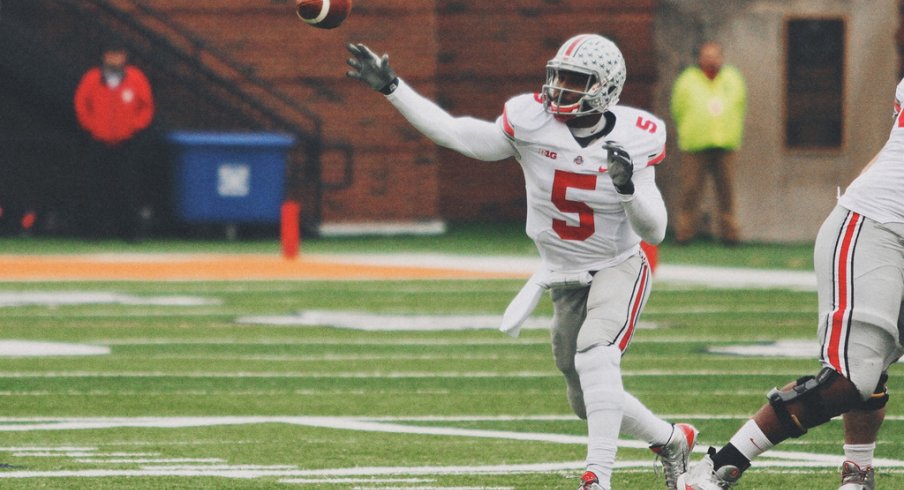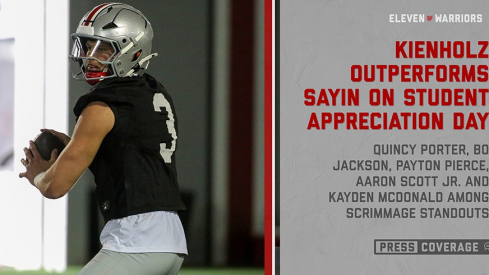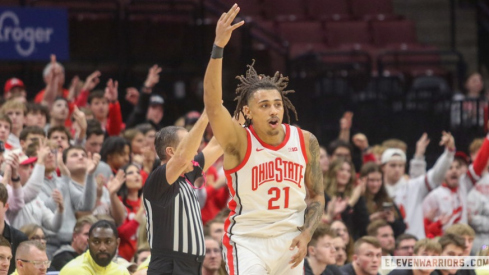Braxton Miller burst onto the Heisman scene as a sophomore. With eye-popping rushing stats, jaw-dropping moves and his team's perfect 12-0 record, Miller finished fifth in the Heisman voting in a year that he supposedly didn't know what he was doing.
Miller did fade a bit down the stretch, allowing Johnny Football to take home the award by shocking Alabama and breaking the SEC total yardage record. Still, a top five Heisman finish and an undefeated regular season set implausible expectations for Miller heading into his junior campaign.
Miller entered 2013 as the favorite to take home the Stiff-Arm Trophy, but he missed time with injuries and again struggled with throwing accuracy late in the season. At season's end he was barely in the conversation, finishing ninth in the voting. Miller's 2013 stats didn't seem much better than in 2012.
| Year | Comp | att | pct | yds | td | int | rush att | rush yds | rush td |
|---|---|---|---|---|---|---|---|---|---|
| 2012 | 148 | 254 | 58.3 | 2039 | 15 | 6 | 227 | 1271 | 13 |
| 2013 | 162 | 255 | 63.5 | 2094 | 24 | 7 | 171 | 1068 | 12 |
There is one exception, and that exception is completion percentage. Braxton Miller's one-year jump of 5.2 percent is the greatest by any Urban Meyer quarterback.
For the first seven games of his season Miller was a Heisman-caliber thrower, one of the best passers in college football. Starting in mid-November, though, he struggled to throw effectively and ran the ball much more. Such a drop-off seeks an explanation.
| Span | Comp | att | pct | yds | td | int | rush att | rush yds | rush td |
|---|---|---|---|---|---|---|---|---|---|
| 8/31–11/2 | 108 | 149 | 72.5 | 1316 | 15 | 3 | 87 | 410 | 2 |
| 11/16–1/3 | 54 | 106 | 50.9 | 778 | 9 | 4 | 84 | 658 | 10 |
I wouldn't attribute it to tougher opponents. In the first grouping of stats, Miller shredded Buffalo (22nd in opposing passing yards per game) and had great passing games against Wisconsin (33rd), Iowa (7th), Penn State (68th) and Purdue (43rd). He looked comfortable standing in the pocket and making quick decisions as well.
The second grouping of stats featured games against Illinois (64th), Indiana (122nd), Michigan (61st) and Clemson (46th). Michigan State's pass defense was very good (4th), but Miller also struggled to throw against Illinois and Michigan.
Poor weather isn't a viable explanation either. The Michigan State game was played indoors, the Clemson game was played in Florida and Ann Arbor's weather for The Game was as nice as I've ever seen it. The Indiana game was snowy, but that was Miller's best passing game in November.
The problem is that Miller was holding onto the ball too long. Miller took six sacks across September and October, compared to 11 in November and the post-season. I don't think the offensive line regressed; I would argue that Miller's tendency to hold onto the ball longer is tied to him being utilized more often as a runner. As Miller's explosiveness in the running game increased, his comfort level in the pocket seemed to decrease. It makes sense – once the mentality shifted to looking for running lanes and big plays on the ground, he may have not kept his eyes downfield as long and lost the rhythm he had in the pocket.
In 2012, Ohio State was 115th in sack percentage with a rate of 9.5% – meaning Ohio State quarterbacks were sacked on nearly one in ten dropbacks. In 2013 that number improved to 6.7%, 80th in the NCAA. Last year, Miller was sacked on 8.2% of his dropbacks and Kenny Guiton on only 0.9% of dropbacks. If we break down the sack rates using the same windows as before, it sheds a bit more light on the situation. In his first seven games, Miller was sacked on 6.7% of dropbacks. In the last five games he was sacked on 10.2% of dropbacks, which across an entire season would rank 122nd.
Miller's ability to make good, quick decisions and accurately deliver the football to his perimeter playmakers will dictate how far Ohio State goes this season. Carlos Hyde masked the drop-off in Miller's passing production in the last month of the season, and now Hyde is gone. As we've already discussed, the offensive line will be good and the running backs should pitch in, but this team will go as far as Miller takes them and likely no further.
Working on the mental part of the game this spring was the best thing that could have happened to Miller, as the team need him to return to early season form to offset the loss of Hyde. If the Miller of this fall is more like the Miller of the first two months of last season, with continued improvement, the Buckeye offense could be a juggernaut.
I took Miller's stats from those first seven games and extrapolated them over an entire 13-game season, also considering that those seven games were really only six games (Miller barely played against SDSU). Here are the results:
| Year | Comp | att | pct | yds | td | int | rush att | rush yds | rush td |
|---|---|---|---|---|---|---|---|---|---|
| 2014 | 234 | 323 | 72.5 | 2851 | 32 | 6 | 188 | 888 | 4 |
The above stats would break single-season records for passing touchdowns, pass completions and completion percentage. It would also make Miller Ohio State's all-time leading passer.
I think the Miller we saw in the earlier part of last season is more of what we'll see this fall. With a murky backup quarterback situation, co-offensive coordinator Tom Herman likely won't call as many designed runs for Miller. At the same time there will be more emphasis on the passing game as the Buckeye offense breaks in a new running game.
If Braxton is even close to how good he's proven he can be throwing the ball, Ohio State will be in great shape to win the Big Ten and advance to the College Football Play-off. Who knows, he might even hear his name called on the second Saturday evening of December.


